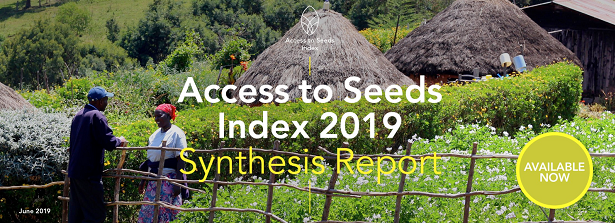Access to Seeds Index 2019 Synthesis Report

The Access to Seeds Index 2019 Synthesis Report has just been released. It describes the opportunities and progress shown by the seed industry, and highlights the importance of local and regional companies in providing access to seeds for smallholder farmers. Challenges differ in each of the three main regions covered by the index: South and Southeast Asia, Eastern and Southern Africa, and Western and Central Africa. Although a lack of access to quality seeds in many emerging economies persists, with companies still only reaching 10% of the world’s smallholder farmers, the overall improvement in performance between 2016 and 2019 indicates the industry’s growing recognition of and more responsive approach toward this significant client group.
Download the Access to Seeds Index 2019 Synthesis Report.
One of the main strategies put forward by the UN to mitigate climate variability and extremes is improving access to new, climate-resilient varieties that are suitable for smallholder farmers. Never before had the UN explicitly underlined the need for and urgency of ensuring that the benefits of modern plant breeding are made accessible to the – mostly small-scale – farmers in the Global South.
Emerging discussions on food system transformation have also highlighted the key role of the seed industry. According to a recent report by the EAT-Lancet Commission, it is possible to feed a global population of 10 billion people without depleting the planet’s resources. However, this requires a shift toward healthier diets and more sustainable production. Growing more nutritious food, based on a more diverse set of crops and plant-based proteins while remaining within planetary boundaries for land use, water use and biodiversity loss are all targets to which the seed industry’s contribution is vital.
Since its establishment in 2012, the Access to Seeds Index has set out to increase transparency around the seed industry and encourage the industry to enhance its contribution to the 2030 sustainable development agenda. The index seeks primarily to identify leadership and good practices, providing an evidence base for the discussion on where and how the seed industry can step up its efforts. Two indexes have been published so far, in 2016 and 2019, with high and increasing participation by companies in data collection, significant media attention globally and a growing stakeholder group.
The index particularly highlights the importance of local and regional companies in providing access to seeds for smallholder farmers. Although most attention goes to globally active seed companies, which dominate many seed markets with advanced breeding programs, the industry is highly diverse and locally driven. Small and medium national and regional companies outperform their global peers in multiple areas relevant for reaching smallholders, but they also provide linkages between farmers and global players through research and distribution partnerships.
Challenges differ in each of the three main regions covered by the index. In South and Southeast Asia, the index identified a highly competitive and research-driven industry. However, leading seed companies reach less than a quarter of the smallholders active in this region. In Eastern and Southern Africa, the main challenge is diversification of breeding activities that currently focus mainly on maize. In Western and Central Africa, practically all countries are covered through a combination of homegrown seed companies, seed-producing cooperatives and companies from outside the region. However, only 11 companies actually breed in and for the region.
Although a lack of access to quality seeds in many emerging economies persists, with companies still only reaching 10% of the world’s smallholder farmers, the overall improvement in performance between 2016 and 2019 indicates the industry’s growing recognition of and more responsive approach toward this significant client group. Coupled with the rising number of homegrown and global seed companies in all regions, the industry has the potential to change this in the coming decade, with possible substantial impacts on Food and Nutrition Security in the countries that need it most.
| Related documents to download |





